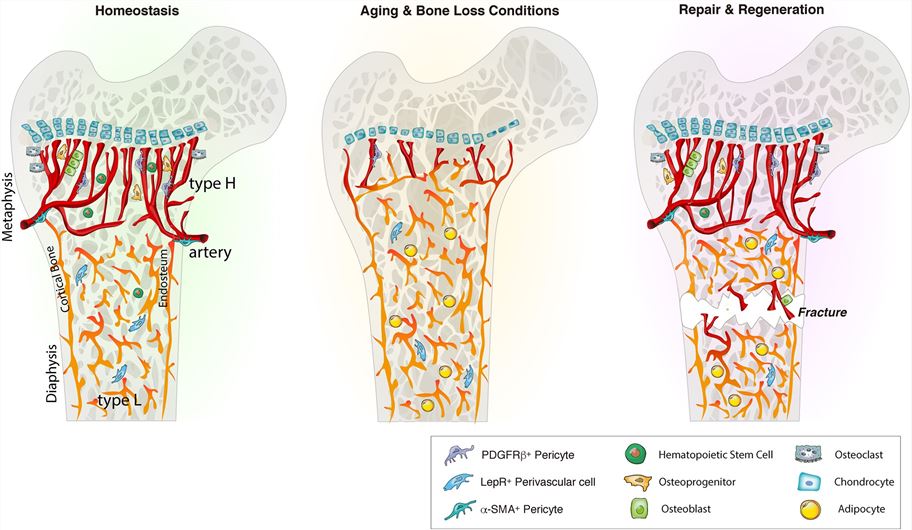Bone-Vascular Tissue Exosome Communication Research Introduction
Osteoporosis (OP) is a systemic metabolic bone disease characterized by microstructural destruction of bone, decreased bone mass, increased fragility, and susceptibility to fracture. Vascular calcification (VC) is the main manifestation of atherosclerosis and the main pathological basis of cardiovascular diseases. Vascular wall calcification caused by VC is closely related to OP caused by calcium loss. Studies have pointed out that VC and OP are opposite to each other. The blockage of the vascular lumen by calcified plaques and the significant abnormal calcification of the vessel wall is often accompanied by a decrease in bone density or a disorder of bone metabolism. Some investigators refer to this phenomenon as a calcified anomaly of the bone-vascular axis. More and more signaling pathways and important molecules have been found to be involved in the communication between VC and OP, such as RANKL–RANK–OPG pathway, Wnt signaling pathway, bone morphogenetic protein (BMP), matrix gla protein (MGP) and bone pontin (OPN).
Exosomes are extracellular vesicles secreted by different cells and present in blood and other body fluids. They are important material carriers for transmitting signals and interacting between cells. Therefore, it is believed that exosomes can deliver these key signaling molecules, which play an important role in communication between bone tissue and vascular tissue for calcification anomalies. Creative Biolabs has established a tissue exosome research service from beginning to end, and has been paying attention to the study of exosome regulation between bone tissue and vascular tissue and can provide customers with corresponding research services.
 Fig.1 Bone marrow blood vessel organization and niche microenvironment in homeostasis, aging and regeneration.1,2
Fig.1 Bone marrow blood vessel organization and niche microenvironment in homeostasis, aging and regeneration.1,2
Research on Exosome in Bone-Vascular Tissue Communication
OP and VC are two important diseases that seriously threaten the health of middle-aged and elderly people. More and more clinical and basic studies have shown that the two are closely related, may share common risk factors, and are regulated by the same pathways, proteins, and hormones. Therefore, a deeper understanding of the link between these two diseases is urgent. Different types of cells in each tissue can release exosomes into the tissue microenvironment. In addition to regulating their own microenvironment, these exosomes can also enter other distant tissues through body fluid circulation to complete the communication between tissues. Based on this, researchers extracted extracellular vesicles (EVs) from aged bone matrix. Through functional experiments in vivo and in vitro, they found that EVs of aging bone matrix carried miR-2861 and transported to the aortic vessel wall, accelerating the process of vascular calcification by promoting the osteogenic transdifferentiation of vascular smooth muscle cells. Moreover, treatment with alendronate sodium was found to significantly inhibit the release of EVs from aging bone matrix, and relieve vascular calcification while inhibiting bone resorption. These findings provide a new theoretical basis for the study of bone-vascular tissue communication.
Current therapeutic agents are unable to limit the progression of vascular calcification while increasing bone mineral density. Therefore, it is urgent to elucidate the bone-vascular tissue communication mechanism and find out key therapeutic targets to alleviate many problems caused by OP and VC in middle-aged and elderly people and improve their quality of life. Creative Biolabs has been a leading global supplier of exosome technology services and can provide the most comprehensive one-stop service for tissue exosomes, including tissue exosome isolation and identification, exosome profiling, exosome proteomics, exosome RNA sequencing, exosome lipidomics and metabolomics, and tissue exosome related services. If you are interested in the mechanism of exosome communication between VC and OP, please feel free to contact us. Based on the most cutting-edge releases and our own rich experience, our professional technical team will provide you with the best experimental solutions and technical services.
References
-
Stucker, S.; et al. bone angiogenesis and vascular niche remodeling in stress, aging, and diseases. Frontiers in Cell and Developmental Biology. 2020, 8:602269.
-
under Open Access license CC BY 4.0, without modification.
For Research Use Only. Cannot be used by patients.
Related Services:

 Fig.1 Bone marrow blood vessel organization and niche microenvironment in homeostasis, aging and regeneration.1,2
Fig.1 Bone marrow blood vessel organization and niche microenvironment in homeostasis, aging and regeneration.1,2









